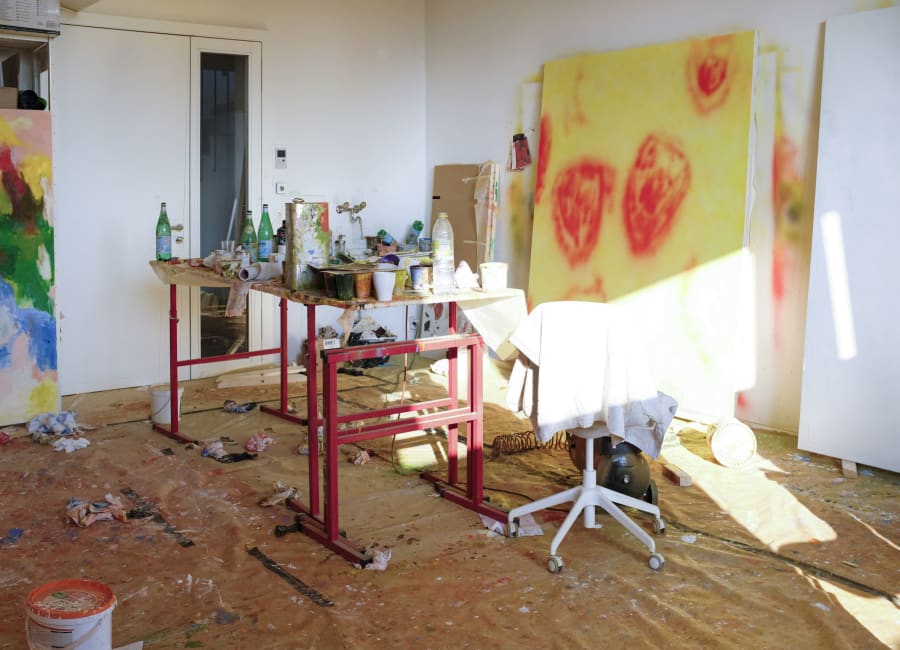Built in the middle of the 18th century, the Grand Chalet in Rossinière, with its 113 windows and scenic surroundings, brings to mind at least two of Switzerland’s defining features: cheese production – for which it was built – and alpine charm. I had left early to take one of the trains that ride up into the region of Pays-d’Enhaut from Lake Geneva before continuing on toward the Bernese Alps, so I had time to check out other historical sites in the village.
At the Balthus Chapel, I watched a few short films about the chalet, which has national heritage status, and the painter Balthus (1908-2001), who lived there from 1977 until his death. One of the videos, filmed in the last few years of his life, shows a joint celebration for the artist’s 88th birthday and his daughter Harumi’s 22nd. The video captures well-known guests (including the musician Bono and the actor Tony Curtis) and conversations where the painter talks about his inspirations (Bonnard, Piero della Francesca), his friends (Artaud, Camus), and even the painting that first provoked his controversial reputation, La leçon de guitare (1934).
在這位德國藝術家於紐約貝浩登(Perrotin)舉辦的首次個展「When the Sun Hits the Moon」中,有幾幅畫作是初次亮相,主題為安東尼奧.卡諾瓦(Antonio Canova)的新古典主義雕塑中描繪的愛神厄洛斯與普姬幾乎接吻的場景。愛神不允許他的世間愛人看到他在光明中的樣子;當普姬拿著蠟燭對著愛神面龐的那一刻,這對戀人就永久地斷開了聯繫。Greven說:「我喜歡這個意象,因為我捕捉到的那一刻,他們還在互相對視,但未真正看見對方的面貌。他們仍處於黑暗之中,以內心注視和以內在擁抱。」
He set up his studio in the hotel’s garage. In summer, you can look through the windows at the dozens of paintbrushes, tubes, and colored powders that are still in their spots. I was lucky enough to get close to the old armchair, the cigarette butts nibbled on by mice, to look at the spiders weave their webs along the high windows. Here, Balthus only painted in natural light. Today, Setsuko disturbs the room as little as possible and is moved whenever she finds a faint trace of him. She had organized his return home from the hospital in January 2001. Balthus wanted to go to his studio. He stayed there for three hours with his wife and daughter, before going to bed and falling into a short coma, dying the following day.
Whoever looks at the facade of the Grand Chalet (and understands French) is reminded that death ‘is born with him,’ that ‘pride is ridiculous and vain,’ and ‘the worms will grow fat on your rotting flesh.’ These foreboding words are engraved along a frieze above the first-floor windows. Higher, there’s the name of Jean-David Henchoz, the farmer and businessman who needed enormous cellars to mature his rounds of cheese and who built the chalet on the same proportions. He died in 1758, two years after it was finished.
Nowadays, the Grand Chalet is a living home, restored with respect for its history. Its residents are all artists. Harumi works on her sculpture and jewelry design in the small former chalet of a shooting club located on the premises. To the side of the sitting room, where we had been drinking tea, the dining room has been set up in a room once occupied by Victor Hugo. On the other side, Setsuko has her studio, where she creates delicate still life paintings, and where she is struggling to finish a large portrait of a hard-eyed Balthus. ‘That was how he looked at his canvases, even though he would touch them with his paintbrush like stroking a baby’s skin.’
Setsuko works on her ceramics in Paris, but she showed me some of her white, thick-trunked trees in the chalet’s cellars. She is represented by Gagosian, which is preparing a Balthus catalogue raisonné. Next door is the huge room built to store cheese. It was used as a dining room by the hotel before hosting art exhibitions up until the 2000s. Now, it is used as a playroom and music room for the children.
Elisabeth Chardon is the co-editor of the quarterly publication La Couleur des jours. She was also the editor in charge of visual arts at the Swiss daily broadsheet Le Temps, with which she still collaborates.
English translation: Catherine Bennett.
First publication: June 23, 2023.
Caption for full-bleed image: Grand Chalet de Rossinière. © Alain Saint-sulpice.


